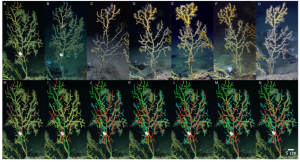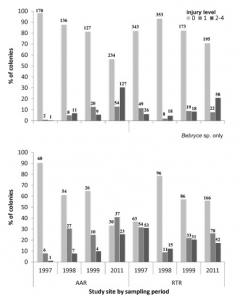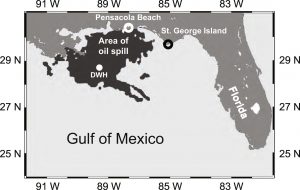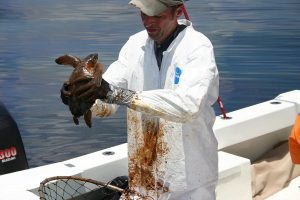Deepwater Horizon Crude Oil and its Implications on the Atlantic Stingray, Hypanus sabinus
By: Casey Dresbach, SRC Intern
Since WWII, the extraction of oil has rapidly revolutionized the way we live. The twentieth century is actually deemed the “century of oil.” The world’s dependency on oil is primarily on Petroleum, also known as crude oil. Crude oil is a complex and naturally occurring mixture of petroleum, which is formed by breaking down large molecules of oils, waxes, and fats (Penn State College of Earth and Mineral Sciences). This is not a modern process and has actually been around for hundreds and millions of years. When marine organisms die, they sink to the bottom of the ocean and are buried in clay, silt and sand. When physical factors come into play – pressure and heat – they facilitate transformation to crude oil. It is stored in impervious rock beneath the earth’s surface. The fuel, which we use today to serve our industrial needs, can be extracted by drilling through this rock. However, crude oil contains a variety of lethal chemical constituents some of which include benzene, hydrocarbons, toluene, and heavy metals (Cave & Kajiura, 2018). Unnaturally high levels of exposure to these chemicals have shown to damage sensory systems in teleost fish, bony fish. Such exposure is due to oil spills, when extraction activities fail to excavate without seepage. The flammable nature of crude oil is subject to possible explosion and fire with faulty production processes. These unnatural spills result in high levels of liquid petroleum releases into the environment.
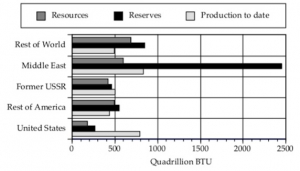
Figure 1. World distribution of petroleum and oil resources.). (Penn State College of Earth and Mineral Sciences)
Most of the world’s petroleum is found in the Middle East (See Figure 1). Yet many countries, including the US, wish to extract oil domestically. Several nations seek out ways in which they can attain the fuel, some of which include large-scale rigs in the middle of the ocean. Deepwater Horizon operated as a floating drilling rig, which functioned to extract oil from deep below the water’s surface. However, on April 20th, 2010 one of the largest spills in the history of marine oil drill operations occurred: The Deepwater Horizon (DWH) oil spill in the Gulf of Mexico on the BP-operated Macondo Prospect. 4 million barrels of oil flowed from the damaged Macondo well over an 87-day period, before it was finally capped on July 15, 2010 (EPA, 2017). 11 workers died and hundreds and thousands of organisms as well as their ecosystems continue to suffer the implications of the explosion.
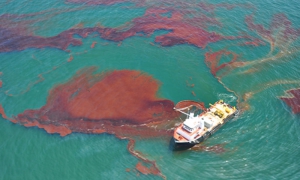
Figure 2. Five years after Deepwater Horizon Oil Spill.) (WWO, 2015).
Spilled oil can harm all kinds organisms, due to the chemical makeup of its poisonous constituents mentioned earlier. In a study conducted by Eloise J. Cave and Stephen M. Kajiura, the impact of crude oil exposure upon sensory function was explored in an organism whose sensory organs are crucial to its existence as a predator (Cave and Kajiura 2018). The Atlantic Stingray, Hypanus sabinus and specifically their impaired olfactory functions as a result of the DWH oil spill were studied in comparison to healthy stingrays. Like all elasmobranchs, these Atlantic Stingrays are renowned for their extraordinary sensory organs. They produce a mucus that exposes the chemosensory cells to the seawater, which allows the stingray to utilize the olfactory system effectively. It also serves as a barrier to provide a protective surface, similar to the jelly-filled pores on a shark’s Ampullae of Lorenzini. The mucus allows for chemical constituents to seep through to the olfactory system, which elicit cues for food availability for instance. If unimpaired, the system enables awareness as predators to both other marine organisms as well as threatening environmental conditions.
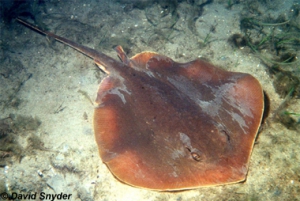
Figure 3. Healthy Atlantic Stingray, Hypanus sabinus.). (Snyder, 2018)
Atlantic stingrays were collected from the Indian River Lagoon in Florida. They were placed in a lab setting – in a holding tank – and tested to determine the toxicological effects of crude oil. The experimental group were exposed to a “high–energy water accommodated fraction (HEWAF) oil solution.” The control experiments were tested under identical conditions in the tank but without the added oil solution. After 48 hours of incubation time, both groups of the population set were probed with a series of amino acids to test the functionality of the sensory organs. This exposure evaluated the transport of what is called “odorants” between seawater environment and the olfactory system. Using three methods of comparison 1) response magnitude, 2) duration, and 3) onset researchers analyzed among stingrays exposed to oil solution with stingrays that were not. Researchers found that when the experimental group was exposed to amino acids, the olfactory organ responses were significantly delayed. Results showed a slower response to the stimuli of amino acids to the stingrays, which simulated those living under unfavorable conditions post DWH spill. They also noticed an increase in mucus production, which could have led to an increase in the amount of chemicals diffused through and thus, heightened impairment.
Even though the DWH oil spill dates back to nearly 8 years ago, marine ecosystems are still enduring the implications of the accident. The study discussed above was the first to employ an “electrophysiological assay to demonstrate crude oil impairment of the olfactory system in a marine fish.” Essentially, showing that elasmobranchs among other marine organisms impacted by an oil spill continually experience decreased olfactory functioning. This not only leads to further predation but also to detriments on the overall fitness of the animal leading to premature death. More research needs to be done with respect to oil spills and their implications because there is potential for certain species to die off leading to a domino effect through lower trophic levels. Oil is an important source of energy to the billions of people on the planet. Yet oil operations must be better maintained and scrutinized to ensure mass spills like the BP oil spill do not occur again. More research needs to be done to regard to the consequences marine organisms are experiencing from the oil spills.
Work Cited:
Cave, E. J., & Kajiura, S. M. (2018). Effect of Deepwater Horizon Crude Oil Water Accommodated Fraction on Olfactory Function in the Atlantic Stingray, Hypanus sabinus. Scientific Reports .
EPA. (2017). Deepwater Horizon – BP Horizon Oil Spill. Retrieved from Environmental Protection Agency (EPA): https://www.epa.gov/enforcement/deepwater-horizon-bp-gulf-mexico-oil-spill).
Penn State College of Earth and Mineral Sciences. (n.d.). Petroleum . Retrieved from https://www.ems.psu.edu/~radovic/Chapter8.pdf
Snyder, D. (2018). Atlantic Stingray. WWO. (2015, April 16). Five Years After Deepwater Horizon Spill. Retrieved from World Wild Life WWO.

